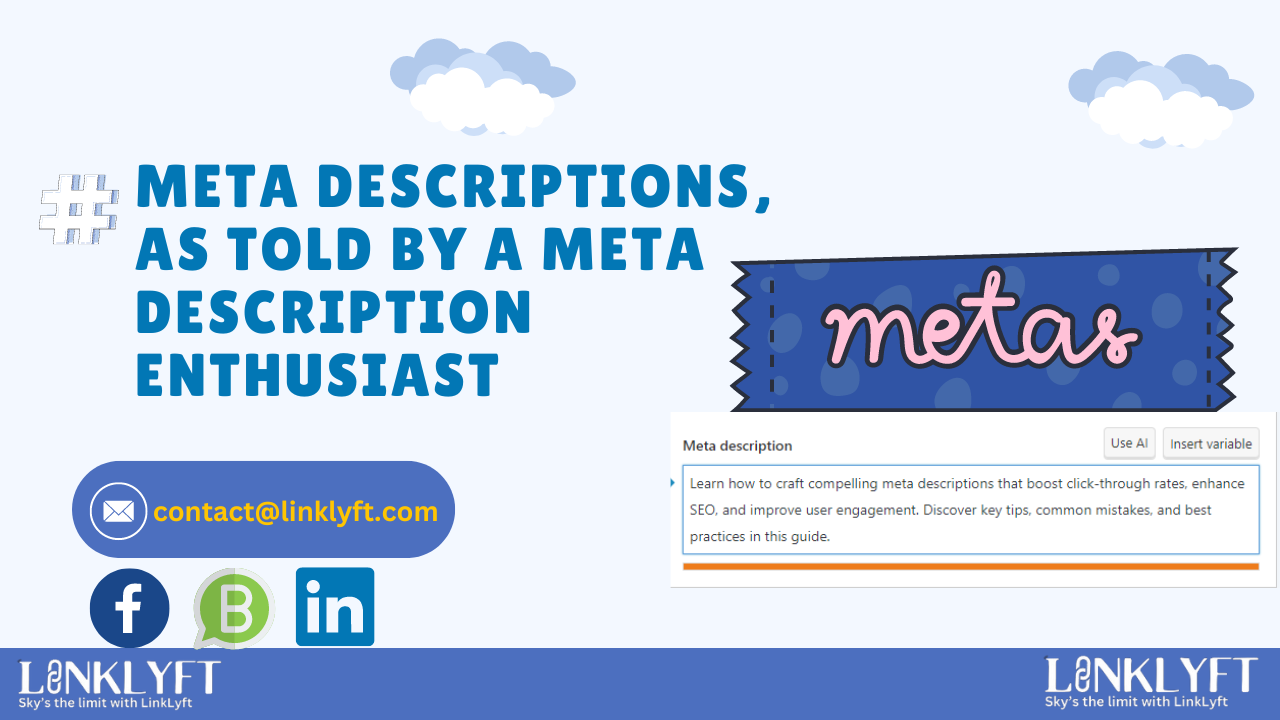Meta descriptions might seem like small pieces of text, but they hold immense power in the digital marketing landscape. As an SEO enthusiast, I’ve seen how the right meta description can make or break a webpage’s performance.
Meta descriptions are not just about cramming in keywords or filling up space – they’re about crafting a compelling narrative that captures a user’s attention and drives clicks. In this blog, we’ll dive deep into the world of meta descriptions, unravel their importance, explore best practices, and address some frequently asked questions.
Why Meta Descriptions Matter: More Than Just a Snippet
Meta descriptions are short summaries of a webpage’s content that appear under the page title in search engine results. Despite being brief – typically around 150-160 characters – they serve as the first point of contact between your content and potential visitors. A well-crafted meta description can:
- Boost Click-Through Rates (CTR): An engaging and relevant meta description can significantly increase the likelihood of users clicking on your link rather than a competitor’s.
- Enhance User Experience: By accurately summarizing what the user can expect, a good meta description helps set the right expectations and reduce bounce rates.
- Support SEO Efforts: Although not a direct ranking factor, meta descriptions indirectly impact SEO by influencing CTR, which search engines monitor as a signal of content relevance.
Think of meta descriptions as the elevator pitch of your webpage – concise, engaging, and persuasive enough to prompt action.
Crafting the Perfect Meta Description: Tips and Techniques

Creating an effective meta-description is both an art and a science. Here are some key strategies to consider:
Understand Your Audience
Before you start writing, understand who you’re writing for. What are their pain points? What solutions does your content offer? Tailoring your meta description to address these questions will make it more appealing.
Include Relevant Keywords
Keywords still matter, but they should be used naturally. Incorporate your primary keyword early in the meta description to signal relevance to search engines and users. However, avoid keyword stuffing – it should read smoothly and naturally.
Focus on Clarity and Conciseness
You have limited space, so every word counts. Use clear, direct language and avoid jargon. Aim for a description that is between 150-160 characters, ensuring that the full text is visible in search results.
Use a Call to Action (CTA)
Encourage users to take the next step with a compelling CTA. Phrases like “Learn more,” “Discover now,” or “Find out how” can nudge readers toward clicking your link.
Common Mistakes to Avoid in Meta Descriptions

While creating meta descriptions, there are common pitfalls that even experienced marketers can fall into:
- Being Too Generic: Avoid generic phrases that don’t provide specific information about your content. Users are more likely to click on links with detailed, relevant descriptions.
- Duplicating Meta Descriptions: Each page on your website should have a unique meta description. Duplicate descriptions can confuse both users and search engines, leading to poor performance.
- Ignoring User Intent: Failing to align the meta description with the user’s search intent can result in missed opportunities. Make sure your description matches what users are looking for.
FAQ’s
No, meta descriptions are not a direct ranking factor in Google’s algorithm. However, they indirectly impact SEO by influencing CTR. A higher CTR can lead to improved rankings over time.
Ideally, a meta description should be between 150-160 characters to ensure it displays fully on both desktop and mobile devices. Search engines may truncate anything longer.
While emojis and special characters can grab attention, they should be used sparingly and only if they align with your brand’s tone and target audience. Overuse can look spammy and may deter clicks.
It’s best to avoid using the same meta description for multiple pages. Each page is unique and should have a distinct meta description to reflect its content and maximize SEO benefits accurately.
Conclusion
Meta descriptions may seem like a small detail, but their impact on your website’s performance is substantial. By crafting clear, concise, and compelling descriptions, you can significantly improve your CTR and, in turn, enhance your website’s overall SEO performance. Remember, a great meta description is more than just an SEO tool – it’s an invitation for users to engage with your content. So, take the time to perfect your meta descriptions, and watch as they help drive more traffic and engagement to your site.
Mohaddis Hayat
Hello! I’m a website manager and co-founder of Linklyft. With a strong focus on SEO, I specialize in keyword research, content optimization, and link-building. My hands-on experience and expertise allow me to enhance search engine visibility, driving online success for businesses. Through tailored strategies, I help companies thrive in the competitive digital landscape, ensuring they achieve their goals effectively.

